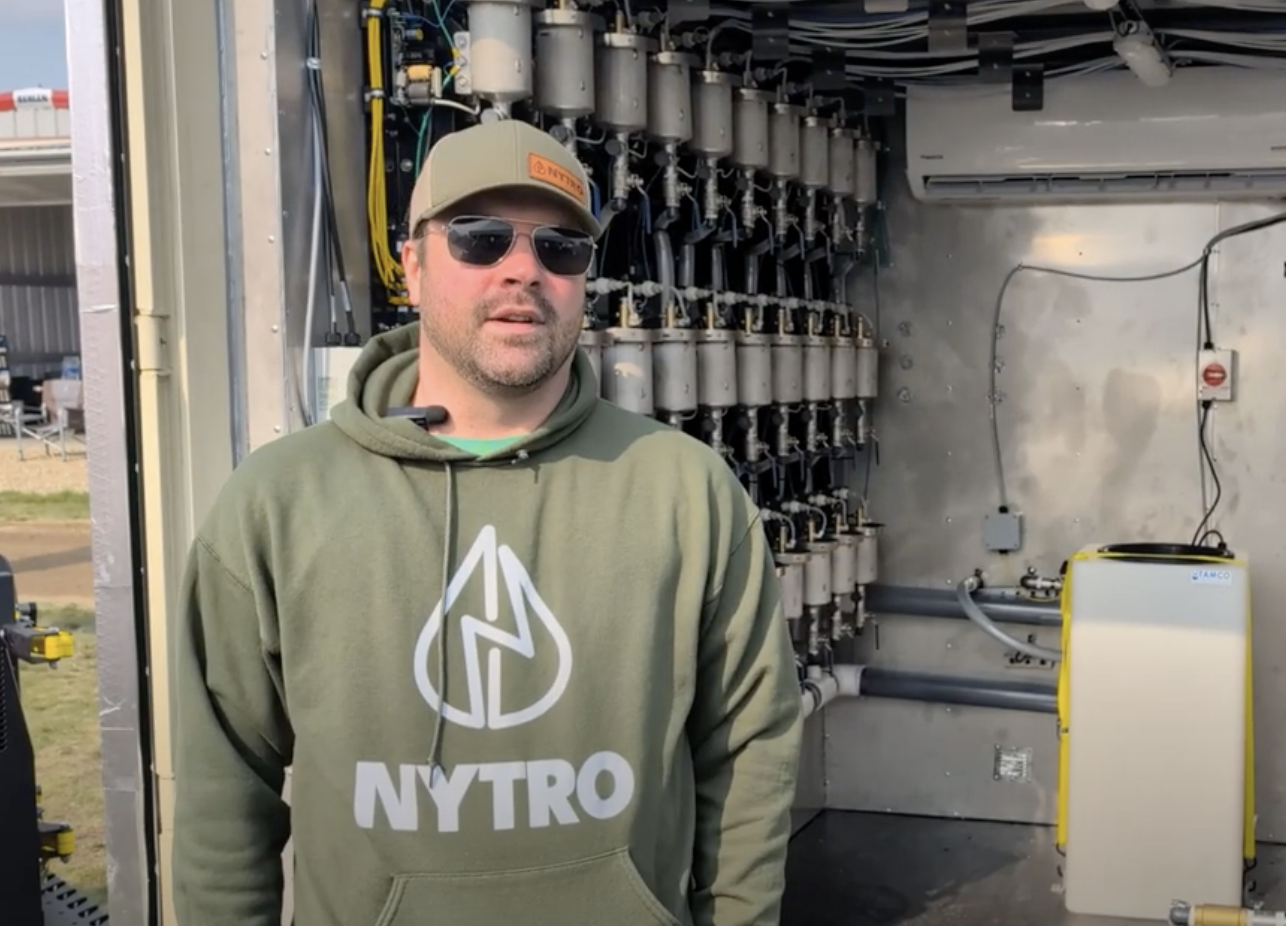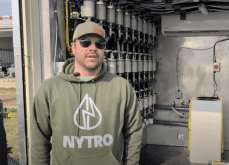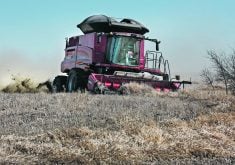HUXLEY, Alta. – Lawrence Moran direct seeds with a 39-foot Flexi-Coil 5000 drill, which is set up with 12-inch spacing and pulls a 1720 three-tank cart, followed by an anhydrous tank.
The star of this show is a third generation hybrid Morris Flexi-Coil Stealth opener that Moran modified himself.
“Originally, we chose Morris openers because we felt they were best for anhydrous. The shanks didn’t freeze up and the tips were adjustable. So we went with the original Morris setup on a Flexi-Coil drill,” said Moran, who farms near Huxley.
Read Also

VIDEO: Green Lightning and Nytro Ag win sustainability innovation award
Nytro Ag Corp and Green Lightning recieved an innovation award at Ag in Motion 2025 for the Green Lightning Nitrogen Machine, which converts atmospheric nitrogen into a plant-usable form.
“You just put the anhydrous hose inside the dry fertilizer hose inside the boot and it acts as insulation. You never get any frost buildup like you can on anhydrous applicators.”
The Morris opener body includes a one-inch diameter hose, normally used for dry fertilizer, which runs through the body and comes out behind the opener point.
Because the anhydrous hose has a smaller diameter, Moran is able to thread the thinner anhydrous hose inside it so that it comes out the bottom. That way, the ammonia comes out right behind the opener tip.
“Another thing with the Morris boot is it has shields on each side of the hole. It allows the product to get right down to the bottom of the trench, before the dirt has a chance to fall back in,” Moran said.
“But we felt the Morris seed boot didn’t direct the seed to the side or even to the back. It just dropped it straight down and we thought we were losing seed down in the trench the tip was making for the anhydrous. We had to make sure the anhydrous was below the seed bed. That was the initial reason for thinking we needed modification.”
Moran kept the front part of the Morris opener, but switched to a Peacock seed boot.
“It spreads (the seed) wider and it has a bull nose on it, to ‘bulldoze’ the trench shut and prevent the seed from going down deep in the middle. They certainly spread the seed: it actually shot it back. We got a nice two row emergence and that’s what we were after.”
But Moran soon found the Peacock was tough to modify.
“We spent two weeks modifying them. We had to make a delivery tube that fit into the Peacock boot and still hook onto the Morris body and it was difficult. We had to bend a long, threaded eight-inch bolt to get it to hook on,” he said.
“Essentially, it did what we wanted it to do. The problem was, they were so hard. And they weren’t made for C-shanks. They actually mounted behind the C-shank and were spring-loaded, so they had some give when they hit a rock. But they didn’t have that much give, other than the C-shank itself. When you hit a rock and the C-shank came back down, it would smash the Peacock seed boot.”
Further investigation turned up the FlexiCoil Stealth seed boot.
“That was the shape we wanted. The plate was easy to modify, so that’s what we did.”
Moran replaced the hand-shaped plate that was originally on the Morris body with the Stealth seed boot, but placed it farther back. He said the new boot accomplished the same results as the original plate, but also delivered the seed underneath the plate.
“They’re essentially the same shape, except the Stealth boot had the seed delivery tubes built right into the closer plate.”
Moran said the first Stealth seed boots didn’t have carbide edges, which won’t last long when direct seeding. FlexiCoil soon came out with carbide edges on the back where the seed is delivered, which made the opener last longer.
“We always did have carbide on the Morris tips. Now the Stealth wear spots have carbide too, so you can maintain the spread on your seed.”
Moran said he didn’t have to make changes to the Morris body. Instead, he made a plate that bolted to the Morris boot and also fit on the Stealth seed delivery boot.
“We have a few problems with the Morris body not being cast. It’s a metal body and it will bend on a rock, so every spring we have to go through and straighten out the bodies on the C-shanks.”
Another concern is the slow speed required to allow the openers to work properly. Four miles an hour is about the maximum speed for oilseeds and cereals to maintain a proper seed pattern.
He can go faster on peas, depending on the stubble, and cereal stubble will also allow faster speeds because the seed boot doesn’t throw the dirt.
“If you go into pea stubble, where it’s not anchored as much, speed will throw the dirt away from the Stealth and it won’t fall back in to close in. The faster you go, the less dirt you get over top.”
Moran tries to seed everything but the peas at about half an inch, which is as shallow as he can go.
“We have to make sure the anhydrous stays in the ground. When we’re doing canola, that’s kind of our depth control. We go as shallow as we can, just to keep the anhydrous in the ground. We can adjust the tip if we want to, but we haven’t done that lately. It’s in the medium position and that puts our anhydrous about an inch to an inch and a half below the seed, where we want it. As far as we can tell, we’re not getting any anhydrous burn on our seed.”
Anhydrous goes down the front while seed and dry fertilizer – Moran uses ammonium sulfate – is delivered above and to the side of the ammonia, through the paired row boot.
“If we want starter N, which we do with the canola, it comes along with the ammonium sulfate. When we’re doing peas, we have a third tank and we use granular inoculant.”
Moran’s first drill had rubber packers, but he traded it for a different drill with steel packers because he liked the shape better than the flat rubber packer.
He said the steel packers promote seed separation because they are round, which allows them to get down in the trench and almost “side pack” the seed.
He also modified the mud scrapers to make them the shape of the packer, which he said is almost essential with the steel packers.
“We don’t have to have them running that close. It seems that if it’s wet and there’s a gap between your scrapers and your wheels, they pick up straw and it works like a brush.”
While he spent the time to make the scrapers the same shape as the packer, in hindsight he said it didn’t matter.
“It’ll wear to what it needs. We went to all the trouble of shaping them exactly the shape of the packer and it just wore it anyways. I can see in certain soil conditions, like heavy clay, it gets on there like pottery and it might not work as well as it does in my loamy soil.”
He also welded a 4.5-inch cold steel plate on each scraper because he wasn’t happy with the Flexi-Coil scrapers.
“They were just 3/4-inch wide pegs, even on the five-inch rubber packers. It just kind of scraped the middle and outside of that scrape point it was supposed to crumble off. That didn’t necessarily work that well, but I’m happy the way these scrapers work.”
While his drill is working well and he doesn’t foresee any major changes to it in the near term, he did say there’s a change he might try if he was to do it again.
“Both Morris and Flexi-Coil have an edge-on shank and I would seriously look at it. The Morris edge-on boot might be a little firmer for standing the rock damage. You might be a little more trash tolerant with the edge-on, but I don’t know that. My neighbour has the edge-on Morris and it does a nice job. You can hardly tell he’s been in the field. But at this stage, we’re going to be using this one.”
















